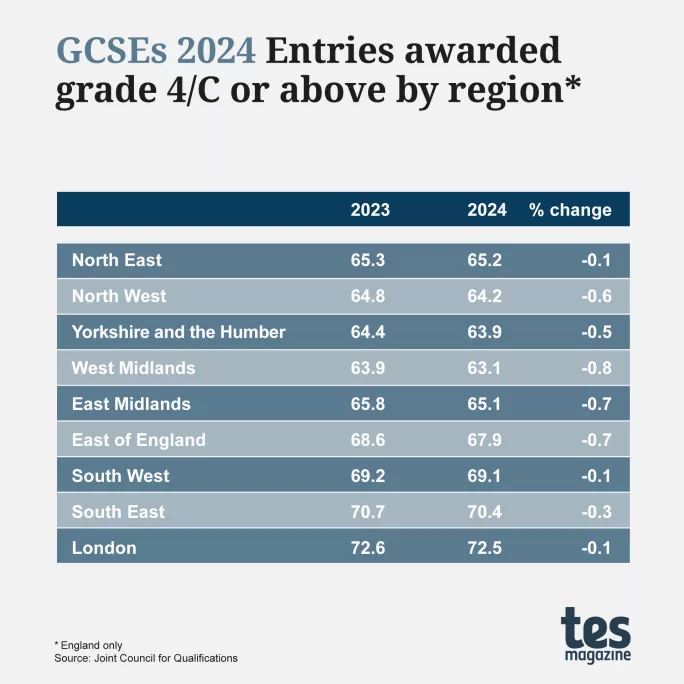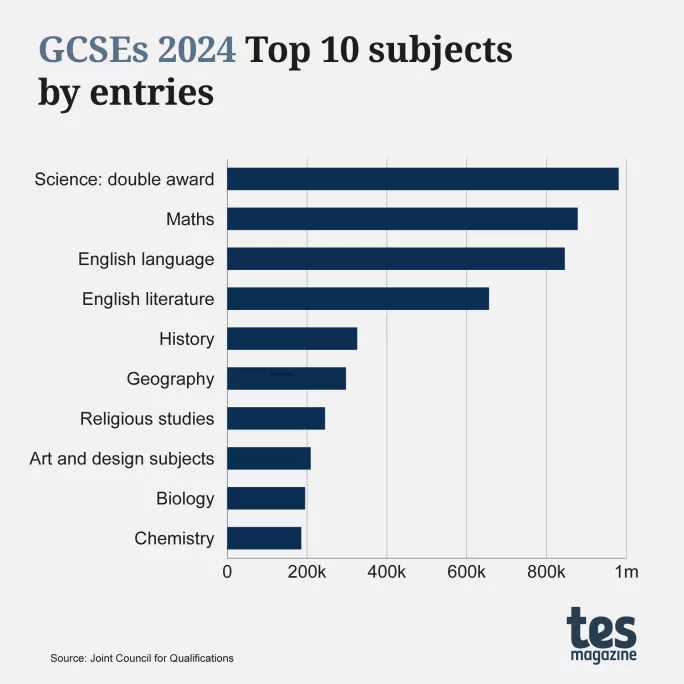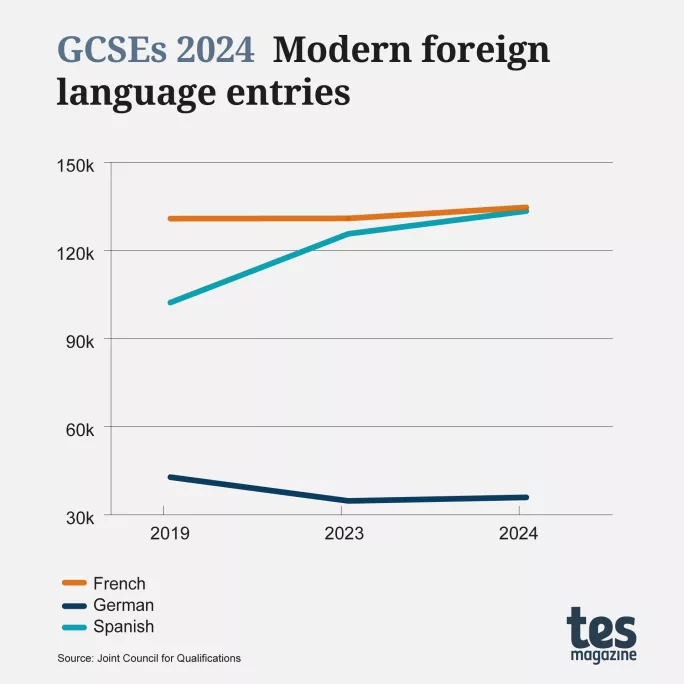9 GCSE trends schools need to know: grades, resits and regions

GCSE results day has arrived, with students across the country collecting results from exams sat earlier this summer.
Beyond the top-level news, there are, as ever, a raft of other insights, trends and statistical quirks from the huge swathe of data released by Ofqual and the Joint Council for Qualifications (JCQ) that Tes has spent the day sifting through.
Here’s everything you need to know:
1. Grade 4/C data paints a confusing picture
While most regions saw an increase in the number of grade 7s and above awarded, the number receiving a ‘standard pass’ of grade 4/C fell in all regions, contributing to the national drop from 67.8 to 67.4 in England (while the UK as a whole fell from 68.2 to 67.6 per cent).
As the table below shows, this was more pronounced in the north than in the south. But all areas, even London, witnessed this decline, as more students fell just short of what is considered a ‘standard pass’ (even though grades 1-3 are actually a pass, too).
Sir Peter Lampl, founder of the Sutton Trust and the Education Endowment Foundation, said the fact declines had been uneven across regions means more must be done to close the attainment gap.
“Stubborn regional disparities in attainment are unchanged...To close these gaps and enable pupils to reach their potential, we need sustained investment in teaching, particularly in areas with lower attainment,” he said.

However, this picture is muddied by resit data. If you look at the statistics for 16-year-olds in England (ie, with no resit data included), grade 4/C outcomes were much higher at 70.4 per cent - a small increase of 0.1 point on 2023.
This difference then is caused by the huge increase in the number of students who took resits, with maths seeing an increase of over 30,000 entries from 154,023 to 185,727, while English language rose from 117,155 to 148,569.
Sadly, for many students sitting English language, they fell short of the grade 4 requirement - with data for 17-year-olds and above showing just 20.9 per cent achieved a grade 4 compared to 25.9 last year. The picture was better for maths though, with 17.4 per cent passing compared to 16.4 last year.
Jon Andrews, head of analysis at the Education Policy Institute (EPI) told Tes this was clear evidence “the resits policy is not working for a large number of young people” - a point echoed by Pepe Di’Iasio, general secretary of the Association of School and College Leaders.
”As this year’s results show, most of these students once again fall short of the grade 4 benchmark in their resits,” he said.
”It is imperative the government’s curriculum and assessment review considers how we can do better for these young people - and a good start would be to scrap the requirements which compel mass resits.”
2. Regional subject uptake disparities
A closer look at regional data shows some stark differences in subject choices across England.
Most notable is economics, where less than 10 per cent of entries were from students in the north of England. This means that of the 7,719 students who sat the subject this year, fewer than 771 came from the north.
The Midlands also had a low proportion of entries in economics, with just more than 20 per cent (about 1,544) in the region. Meanwhile, almost 70 per cent (about 5,400) of economics entries were from students in the south.
Regional disparities were also evident in drama, where less than 20 per cent of national entries came from students in the north - while similar splits can be seen with music and computing.
Chris Zarraga, director of Schools North East, said the disparity in take-up of certain subjects underlined many long-standing issues in the region.
“Schools, especially those in isolated geographies, struggle to recruit a range of school staff, especially in certain subject areas such as economics, music, or modern foreign languages,” he told Tes. He lamented, too, that the pandemic had made this situation worse.
“Stretched budgets and recruitment challenges mean an inevitable narrowing of the curriculum.”
3. Subject popularity
The top ten most popular subjects have stayed the same this year.

While the positions are unchanged, there are some interesting data points to note.
Maths entries increased by 6.9 per cent compared to 2023 (from 821,322 to 878,165), and English language entries by 7.2 per cent (from 788,780 to 845,834) - reflecting the population increase that has led to a 4.50 per cent increase in GCSE entry numbers this year.
Conversely, while numbers of students taking GCSE religious studies rose very marginally from 222,412 in 2023 to 223,034 in 2024 (0.28 per cent), entries in the subject as a percentage of the total number of entries have fallen.
4. Subjects growing in popularity
Continuing its upward journey from last year, business studies saw the biggest increase in entries again this year, rising 9.7 per cent, from 123,166 entries in 2023 to 135,090 in 2024.
English language - which last year was the fifth biggest riser - moved up to second this year.
And it’s even better news for art and design subjects, which were last year in decline. In 2024, entries have risen 5.4 per cent, from 198,302 to 208,934.

5. MFL on the up - but all is not as it seems
It’s also good news for modern foreign languages (MFL), which have seen an increase in entries after being in decline in recent years. There was a 2.9 per cent increase in French, 3.5 per cent in German, 6.2 per cent in Spanish - and 8.1 per cent in other MFL entries.
Vicky Gough, British Council schools adviser, said it was “wonderful to see a rise in the uptake of all languages” given the benefits they offer, from “better intercultural skills for the individual to economic advantages for the UK”.

David Blow, fellow of the Association of Language Learning, also welcomed the news, but noted that Spanish is the only subject that saw an increase higher than the national increase of 4.5 per cent, while “German and French are below the national increase”.
Furthermore, he says that the rise seen is not linked to changes to grading standards that Ofqual announced in July, intending to bring French and German (as well as computer science) more in line with other subjects, and that this remains a concern.
“They’ve made some changes, which is good news for thousands of students,” Blow says. “But French, German and Spanish are all still severely graded relative to other EBac subjects, so the underlying problem is still there.”
6. Gender split on subject entries
Just as with A levels last week, the GCSE entry data reveals a clear gender divide in certain subjects, chiefly with far more boys taking certain Stem subjects than girls.
As the table below shows, there are several subjects where over 70 per cent of entries were by boys, notably engineering, computing and construction. Meanwhile, girls dominate entries for home economics, performing/expressive arts, and health and social care.
It is worth noting though that all of these subjects have low entry numbers with all under 10,000, with the exception of computing which has risen to over 95,000 entries.

7. Girls vs boys - the gap closes
Regardless of subject choices though, girls outperform boys across results from grade 4/C and above. Specifically, girls achieved 73.7 per cent of entries at grade 4/C and above this year, compared to 67.1 per cent for boys.
However, despite this gap, the EPI noted in an analysis of the data that this gap between boys and girls is narrowing and is now 2.2 percentage points lower than it was in 2019.
“This has been driven by the percentage of boys achieving grade 4 or above increasing, while the percentage for girls has decreased,” it added.
8. Number of GCSEs taken remains steady
As has been the case for the past six years, the average number of GCSEs has remained relatively constant, with 2024’s average figure of 7.81 the same as last year and slightly up on the 7.78 in 2022.
In total, 28.4 per cent of students took nine GCSEs, while 25.1 per cent took eight. Seven is the next most popular number, taken by 15.6 per cent, followed by 10 GCSEs taken by 12.2 per cent.
Taking 12 or more GCSEs is very rare, with only 0.1 per cent, or 390 students, taking this option.
9. The all-9s brigade
Ofqual also offered up an insight into the number of students who received all grade 9s in their exams, with a total of 1,270 students achieving this notable feat.
The number of GCSEs sat by the students achieving all grade 9s is as follows:
- 7 GCSEs: 95
- 8 GCSE: 145
- 9 GCSEs: 340
- 10 GCSEs: 545
- 11 GCSEs: 145
Overall, the gender split of those achieving this was 65 per cent for girls and 35 per cent for boys.
For the latest education news and analysis delivered every weekday morning, sign up for the Tes Daily newsletter
You need a Tes subscription to read this article
Subscribe now to read this article and get other subscriber-only content:
- Unlimited access to all Tes magazine content
- Exclusive subscriber-only stories
- Award-winning email newsletters
Already a subscriber? Log in
You need a subscription to read this article
Subscribe now to read this article and get other subscriber-only content, including:
- Unlimited access to all Tes magazine content
- Exclusive subscriber-only stories
- Award-winning email newsletters
topics in this article



